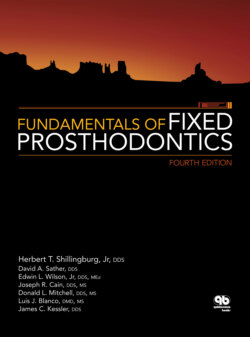Читать книгу Fundamentals of Fixed Prosthodontics - James C. Kessler - Страница 72
Mounting the maxillary cast
ОглавлениеThe incisal guide block is removed from the articulator and replaced with the articulator index (Fig 5-46). The vertical reference pin of the bite fork assembly is inserted into the hole on the top of the articulator index. The reference pin has a flat side, which will match a flat side on the hole. The numbers 1 and 2 on the clamps of the bite fork assembly should be upright. The set screw at the front of the index is tightened.
Clean mounting plates are secured to the upper and lower members of the articulator. The articulator is assembled by placing the fossae over the condyles. The incisal pin is placed at the zero position. The long incisal pin for the dimpled guide block will rest in the recessed center of the index. The short pin used for flat guide blocks will contact the sliding metal piece in the middle of the index. The incisal pin with the adjustable foot sits on the posterior section of the index. The upper member of the articulator is removed and set on the top of the bench with the mounting plate up.
The maxillary cast is soaked, tooth side up, in a plaster bowl containing only enough water to wet the sides and bottom of the cast. The cast is seated into the wax registration on the bite fork (Fig 5-47). Mounting stone is mixed to the consistency of thick cream. A golf ball–sized mound of stone is applied to the base of the cast and the mounting plate. The articulator is assembled by placing the fossae over the condyles. The upper member of the articulator is closed into the soft mounting stone until the incisal guide pin contacts the appropriate spot on the articulator index. The centric latch is locked by pushing it into the down position.
The mounting stone will engage undercuts in the mounting plate and cast. Additional stone can be added if needed to secure the mounting. When the stone has set completely, the transfer jig is removed from the articulator. The incisal guide block is replaced in the articulator. The transfer jig is then rinsed with a hospital-grade disinfectant and stored until ready to be used again. All registration material is removed from the bite fork, which is then placed in a sealed sterilization bag and submitted for steam sterilization.
